 Korg C1 Air Digital Piano | UPDATED REVIEW – June 2, 2024 | LOWER PRICE HERE | Korg is a well known music products manufacturer which is based in Japan. They have been designing and producing a variety of pro and home music products for over a half century and continue to be a leader and innovator in the digital music world. With regard to digital pianos, Korg has an impressive model called the C1 Air home digital piano at $1599 internet discount price which incorporates the newer Korg piano technology at a relatively low competitive price. This model comes in a nice array of cabinet finishes including matte black, matte rosewood, and matte white.
Korg C1 Air Digital Piano | UPDATED REVIEW – June 2, 2024 | LOWER PRICE HERE | Korg is a well known music products manufacturer which is based in Japan. They have been designing and producing a variety of pro and home music products for over a half century and continue to be a leader and innovator in the digital music world. With regard to digital pianos, Korg has an impressive model called the C1 Air home digital piano at $1599 internet discount price which incorporates the newer Korg piano technology at a relatively low competitive price. This model comes in a nice array of cabinet finishes including matte black, matte rosewood, and matte white. The first thing that shoppers generally want to know concerning digital pianos is about the key action. How does it move, how does it feel, how will it hold up over time, is the key action quiet or noisy, will it emulate a real piano action, and most of all, is the key action good enough so I grow into it rather than grow out of it? Piano teachers, like myself, also feel the key action is the most important part of any piano whether that piano is acoustic or digital so it is the number one thing to be concerned about, especially if you are a piano student or someone who plays well.
The first thing that shoppers generally want to know concerning digital pianos is about the key action. How does it move, how does it feel, how will it hold up over time, is the key action quiet or noisy, will it emulate a real piano action, and most of all, is the key action good enough so I grow into it rather than grow out of it? Piano teachers, like myself, also feel the key action is the most important part of any piano whether that piano is acoustic or digital so it is the number one thing to be concerned about, especially if you are a piano student or someone who plays well. The best way for me to describe the RH3 key action is to say it’s very impressive given the low price of the C1 Air model. In my opinion the feel of the RH3 key action movement is so good, so organic, and so responsive for a lower priced digital piano like the C1 Air you really get the impression you’re playing a real acoustic piano.
The best way for me to describe the RH3 key action is to say it’s very impressive given the low price of the C1 Air model. In my opinion the feel of the RH3 key action movement is so good, so organic, and so responsive for a lower priced digital piano like the C1 Air you really get the impression you’re playing a real acoustic piano.
The RH3 action is balanced well up and down the keyboard as well as front to back of the keys as compared to many other digital pianos in this price range, properly graded in down weight movement and is not too heavy and not too light. The overall movement of the keys really allows a player to connect with their music and feel like they can really express themselves.
There is only one other key action brand in a furniture cabinet digital piano under $2000, in my opinion, that feels as good (and maybe a bit better) than this Korg top-of-the-line key action in terms of the way it moves. Yes, there are other key actions that are nice to play from Kawai, Roland, Casio, and Yamaha, but the Korg RH3 key action is really in a special class as I am concerned, plus, it’s a noticeably quieter key action in terms of noise coming from the keys when they move up & down as compared to many other digital pianos out there.
 There are two things about this key action that Korg does not offer which a few other key actions in this price range do offer and that is “ivory & ebony feel keytops” and/or “escapement function.” Some of the digital piano manufacturers are producing a special material that goes on the tops of the keys which tries to simulate the old ivory and ebony that regular acoustic pianos used to have many decades ago. Ivory and ebony haven’t been used on regular piano keys in a very long time so what real piano keys have had for many years is the hard white implex acrylic key tops and black matte keytops. Ivory and ebony had a different appearance than they way acoustic piano keys are now and one of the properties of Ivory and ebony is that they were a porous organic material so they helped to absorb sweat from the fingers although the sweat discolored those materials after awhile. With regard to the “escapement” key function, this feature is found mostly on grand pianos when you press a key very slowly you would feel a hesitation or notch about half-way down key as the key is depressed very slowly.
There are two things about this key action that Korg does not offer which a few other key actions in this price range do offer and that is “ivory & ebony feel keytops” and/or “escapement function.” Some of the digital piano manufacturers are producing a special material that goes on the tops of the keys which tries to simulate the old ivory and ebony that regular acoustic pianos used to have many decades ago. Ivory and ebony haven’t been used on regular piano keys in a very long time so what real piano keys have had for many years is the hard white implex acrylic key tops and black matte keytops. Ivory and ebony had a different appearance than they way acoustic piano keys are now and one of the properties of Ivory and ebony is that they were a porous organic material so they helped to absorb sweat from the fingers although the sweat discolored those materials after awhile. With regard to the “escapement” key function, this feature is found mostly on grand pianos when you press a key very slowly you would feel a hesitation or notch about half-way down key as the key is depressed very slowly.
I personally would much rather have a key action that moves very smoothly like the Korg RH3 rather than a heavy, fragile, or unresponsive key action that has the artificial keytops and escapement. That’s how much I enjoy playing the Korg C1 key action over many other digital pianos, even some of the key actions in the $2500 price range!
 Piano sound is a tricky thing because for many people who don’t have piano playing or piano listening experience, they may not know what a piano is actually supposed to sound like? In other words a piano shopper could mistake poor piano sound reproduction in a digital piano with something they think sounds OK or good. I see this happen all the time because a lot of people don’t know what it actually takes for a real piano to sound good and natural. There are so many organic resonances and vibrations going on in a real piano when it’s being played, and to reproduce all those natural organic piano tones, string vibrations, and cabinet vibrations is not easy in a digital piano.
Piano sound is a tricky thing because for many people who don’t have piano playing or piano listening experience, they may not know what a piano is actually supposed to sound like? In other words a piano shopper could mistake poor piano sound reproduction in a digital piano with something they think sounds OK or good. I see this happen all the time because a lot of people don’t know what it actually takes for a real piano to sound good and natural. There are so many organic resonances and vibrations going on in a real piano when it’s being played, and to reproduce all those natural organic piano tones, string vibrations, and cabinet vibrations is not easy in a digital piano.Some poor sounding digital pianos like some models made by Artesia, Suzuki, Kurzweil, and others have very poor (almost embarrassing) piano sound reproduction and in fact a few of those pianos sound like toys in my opinion. Good, expressive, dynamically exciting piano tone is important especially for students who want to grow in their musical abilities and for people who already play well and want a better, more natural piano sound experience. So when I played the Korg C1 Air, I was not only impressed with the stereo piano sound itself, but was also impressed with how big and full it was. This piano may be compact in looks but it is definitely not compact in piano sound.
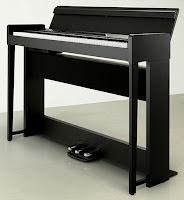 To help that piano sound chip along, the C1 Air has the most powerful internal speaker system in this price range (less than $1600) that I have ever heard. At 50 watts of power with 2 specialty speakers housed in its own speaker box pointing towards the player and the room, the fullness and big bass reproduction of the speaker system produces an impressive stereo piano sound that really does sound as big and full as an acoustic grand piano.
To help that piano sound chip along, the C1 Air has the most powerful internal speaker system in this price range (less than $1600) that I have ever heard. At 50 watts of power with 2 specialty speakers housed in its own speaker box pointing towards the player and the room, the fullness and big bass reproduction of the speaker system produces an impressive stereo piano sound that really does sound as big and full as an acoustic grand piano.
I don’t know how Korg does it in such a compact cabinet footprint but if you had your eyes closed and heard this C1 Air piano sound you would think the piano was three to four times a big as it really is…quite impressive actually. Also, because the internal speakers are not under the cabinet pointed down to the floor like so many other digital pianos in this price range are including from Roland, Yamaha, Kawai, and others, the powerful front facing speaker system in this piano really does fill up a larger room without a problem with a sound like a baby grand piano.
But for most people the piano sound of the C1 Air will be more than sufficient and natural and you can enjoy it very much. You can also spend less money and get a good piano playing experience in other digital pianos and you can certainly spend a lot more money and get an even more authentic piano playing experience in another digital piano like the higher priced Korg G1 Air. But if you want to keep the price between $1000 – $1600 then the Korg C1 Air should be a definite consideration.

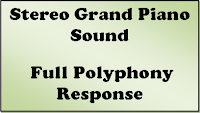
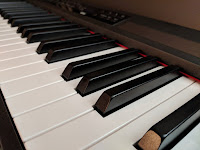 OK…so how about polyphony…some people wonder if that specification really matters and if they should be concerned about it? The answer is…polyphony only really matters if when you play the piano the notes all play and sound normal and sustain properly without notes abruptly dropping out. If the piano you are playing can play normally without any issues then the amount of polyphony it has in it will be enough. If the piano sound has sudden interruptions of notes when playing the piano normally then there is not enough polyphony, otherwise known as piano processing power.
OK…so how about polyphony…some people wonder if that specification really matters and if they should be concerned about it? The answer is…polyphony only really matters if when you play the piano the notes all play and sound normal and sustain properly without notes abruptly dropping out. If the piano you are playing can play normally without any issues then the amount of polyphony it has in it will be enough. If the piano sound has sudden interruptions of notes when playing the piano normally then there is not enough polyphony, otherwise known as piano processing power.
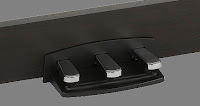 When it comes to pedaling, that is a part of piano playing which can be easily overlooked, especially if you are a novice or have never played a piano. In the beginning using pedals, especially the damper-sustain pedal, is not something that you do until you are well into your lessons and maybe not even until a year later will you need to put any emphasis on pedals and how they work and how you use them. However, if you keep practicing or you already play piano then having good working pedals that operate properly is an absolute necessity, particularly with the right pedal (not center or left) which is called the damper or sustain pedal.
When it comes to pedaling, that is a part of piano playing which can be easily overlooked, especially if you are a novice or have never played a piano. In the beginning using pedals, especially the damper-sustain pedal, is not something that you do until you are well into your lessons and maybe not even until a year later will you need to put any emphasis on pedals and how they work and how you use them. However, if you keep practicing or you already play piano then having good working pedals that operate properly is an absolute necessity, particularly with the right pedal (not center or left) which is called the damper or sustain pedal.Beyond that, the pedal sustain decay time and volume needs to be long and full for all notes and that is definitely something I find missing on many digital pianos because of using cheap pedal parts and limited memory for decay & sustain time and volume. In other words, if the pedals are not working like a real piano and the piano sustain tone is not sounding like a real piano then you will likely be very sorry later on when you discover it because there is nothing you can do to change it if its not good.
 Another thing about the pedals on the Korg C1 Air is that I was very impressed with their ability to play responsively, feel like they are built well and durable with a very quiet pedal movement, and I was especially impressed with the sustain pedal piano decay time and sustained volume loudness across all 88 keys when using the damper pedal. In other words you can hear the notes you are playing blend altogether in a natural way with no choppiness or quick decay time like you might hear on some other digital pianos. The notes resonated for a very long time while holding down the damper pedal with lots or organic sympathetic string vibrations being heard.
Another thing about the pedals on the Korg C1 Air is that I was very impressed with their ability to play responsively, feel like they are built well and durable with a very quiet pedal movement, and I was especially impressed with the sustain pedal piano decay time and sustained volume loudness across all 88 keys when using the damper pedal. In other words you can hear the notes you are playing blend altogether in a natural way with no choppiness or quick decay time like you might hear on some other digital pianos. The notes resonated for a very long time while holding down the damper pedal with lots or organic sympathetic string vibrations being heard.
Also, the C1 Air produces realistic damper resonance when applying the damper pedal to give the piano tone, particularly in the upper octaves, a natural texture and resonance to the piano sound that is definitely heard on all real acoustic pianos but is missing on some digital pianos. Without these natural tonal resonances provided by the C1 Air pedals and the piano sound chip, a digital piano sound can be very artificial and fake, but in my opinion the Korg C1 Air really shines through and sounds much more like a real live piano with more sonic textures.
Other digital pianos I have played in or near this general price range can have clunky, noisy pedals either when the pedal goes down, comes back up, or both. With the Korg C1 Air the pedals are smooth moving and quiet and there is a support platform under all three pedals, and when you’re playing the piano at lower volumes or with headphones then that quiet pedal action is very helpful to the overall enjoyment of your piano playing.
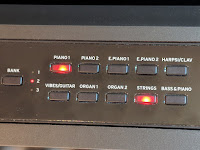 There is a lot a person can do with the functions and features of the C1 Air and it offers a variety of different instrument tones from a total of 30 individual sounds within 10 group instrument buttons with 3 variations per button with 26 of those sounds being non-acoustic piano instruments which include some impressive string symphony sounds, organs, electric pianos, harpsichords, and other usable tones. As I mentioned before there are 2 main stereo piano sounds including a German Steinway concert grand piano and a Japanese Yamaha concert grand. Korg also provides a few acoustic piano variations of those 2 concert grand pianos and I found overall that the variations are quite different as compared to their original tone because the original Steinway and Yamaha piano samples on the C1 Air have an abundance of pedal resonance being triggered when using the damper-sustain pedal.
There is a lot a person can do with the functions and features of the C1 Air and it offers a variety of different instrument tones from a total of 30 individual sounds within 10 group instrument buttons with 3 variations per button with 26 of those sounds being non-acoustic piano instruments which include some impressive string symphony sounds, organs, electric pianos, harpsichords, and other usable tones. As I mentioned before there are 2 main stereo piano sounds including a German Steinway concert grand piano and a Japanese Yamaha concert grand. Korg also provides a few acoustic piano variations of those 2 concert grand pianos and I found overall that the variations are quite different as compared to their original tone because the original Steinway and Yamaha piano samples on the C1 Air have an abundance of pedal resonance being triggered when using the damper-sustain pedal.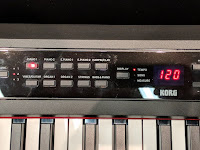 The damper resonance on the C1 Air is like hearing a lot of natural echo in a regular acoustic grand piano when the felt dampers are off the strings while holding down the damper-sustain pedal as you are playing notes.It’s very impressive and adds a of character to the over piano sounds. Two of the piano variations of both piano tones do not have the damper resonance effect so the sound is a lot more plain without any echo at all while the other variation on the Steinway grand piano tone also has damper resonance but starts off a bit brighter in done as you play more delicately.
The damper resonance on the C1 Air is like hearing a lot of natural echo in a regular acoustic grand piano when the felt dampers are off the strings while holding down the damper-sustain pedal as you are playing notes.It’s very impressive and adds a of character to the over piano sounds. Two of the piano variations of both piano tones do not have the damper resonance effect so the sound is a lot more plain without any echo at all while the other variation on the Steinway grand piano tone also has damper resonance but starts off a bit brighter in done as you play more delicately.Some people may like a plainer tone without the resonance effect but others will enjoy the full resonating piano tones when the damper resonance effect is automatically applied when using the C1 Air damper pedal. I personally prefer the natural damper resonance which adds a lot of tonal flavor and color to the music.
When I use the damper/sustain pedal while playing the sustaining tones like organs, strings, choirs, etc, the sustain pedal will hold those sounds and keep them going continuously (like the real thing) until I let go of the pedal and then they stop…just another feature on the C1 Air that makes playing those sounds even more enjoyable and definitely the best I have heard under $2000 in a furniture cabinet digital piano. What really makes it all come together is hearing these non-piano sounds some through the impressive C1 Air internal speaker system that pretty much blows anything else away in this price range, but I talk more about those things below, later on in this review.
As far as other things you can do with the instrument sound selections is being able to mix (layer) any 2 of the instrument sounds together by pressing any 2 inst![]() rument buttons at one time to mix those sounds to play a song. So whether it’s a guitar with choir or piano with strings, or even 2 different acoustic pianos mixed together at the same time, the C1 Air can do it well. So let’s say that you want to use the C1 Air in a church. You can layer/mix one of the impressive pipe organ sounds with one of the big acoustic grand piano sounds and play them together simultaneously. Or maybe you want a baroque
rument buttons at one time to mix those sounds to play a song. So whether it’s a guitar with choir or piano with strings, or even 2 different acoustic pianos mixed together at the same time, the C1 Air can do it well. So let’s say that you want to use the C1 Air in a church. You can layer/mix one of the impressive pipe organ sounds with one of the big acoustic grand piano sounds and play them together simultaneously. Or maybe you want a baroque  harpsichord tone mixed with a concert string symphony sound…well you can do that too and those two sounds are being played together.
harpsichord tone mixed with a concert string symphony sound…well you can do that too and those two sounds are being played together.
Although I like having a proprietary controller app which some other manufacturers provide for their digital pianos, you always need to have your iPad connected and opened up to use the app and it can also get in the way of you easily accessing and using all those cool educational or “music playing” apps that you may want to interact with instead of the controller app.
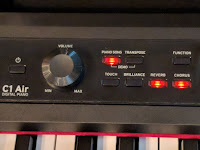 The C1 Air control panel is located on the top left hand side of the piano above the keyboard. It consists of a large, easy to use master volume knob and 6 direct access buttons near the master volume know. Those 6 buttons consist of accessing the song playback system, transpose key, touch sensitivity control, brilliance adjustments, reverb echo effects, and chorus effects. Many digital pianos in this price range don’t have all of these important direct access buttons to quickly use popular features so it’s a lot less intuitive to find those features in other digital pianos using their digital piano operating system.
The C1 Air control panel is located on the top left hand side of the piano above the keyboard. It consists of a large, easy to use master volume knob and 6 direct access buttons near the master volume know. Those 6 buttons consist of accessing the song playback system, transpose key, touch sensitivity control, brilliance adjustments, reverb echo effects, and chorus effects. Many digital pianos in this price range don’t have all of these important direct access buttons to quickly use popular features so it’s a lot less intuitive to find those features in other digital pianos using their digital piano operating system.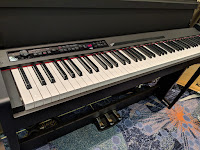 on buttons are the 10 instrument group buttons (as mentioned above) with 3 variations (called banks) in each group for a total of 30 internal instrument tones as I mentioned before.There is a function button within that group of 6 direct access buttons and the function button allows you to edit a number of things within the piano. You just touch the function button and then the 10 instrument sound group buttons become the different function access buttons for those editing features. Included in those editing functions are master pitch change, 3 new temperament scales, relative volume balance when layering/mixing 2 instrument sounds together, octave change mode, and a few other useful functions.
on buttons are the 10 instrument group buttons (as mentioned above) with 3 variations (called banks) in each group for a total of 30 internal instrument tones as I mentioned before.There is a function button within that group of 6 direct access buttons and the function button allows you to edit a number of things within the piano. You just touch the function button and then the 10 instrument sound group buttons become the different function access buttons for those editing features. Included in those editing functions are master pitch change, 3 new temperament scales, relative volume balance when layering/mixing 2 instrument sounds together, octave change mode, and a few other useful functions.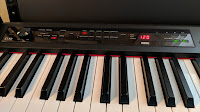 There is an LED display on the right side of the instrument group buttons that reads out the various names of instruments and functions when they are selected. I would have preferred an LCD display which would have been more effective and intuitive to use but Korg chose the older style red letter LED display. It actually works fine because there aren’t that many functions on the C1 Air to figure out which is helpful.
There is an LED display on the right side of the instrument group buttons that reads out the various names of instruments and functions when they are selected. I would have preferred an LCD display which would have been more effective and intuitive to use but Korg chose the older style red letter LED display. It actually works fine because there aren’t that many functions on the C1 Air to figure out which is helpful.
 The C1 Air also has a mode called “Piano Partner” which allows two people to play or practice the same song playing the same notes in the same octave. This is good if there is a piano-student, parent-child, of 2 siblings who are wanting to play the same song. The piano electronically divides the 88 notes into two 44-note keyboards for each person to play.
The C1 Air also has a mode called “Piano Partner” which allows two people to play or practice the same song playing the same notes in the same octave. This is good if there is a piano-student, parent-child, of 2 siblings who are wanting to play the same song. The piano electronically divides the 88 notes into two 44-note keyboards for each person to play.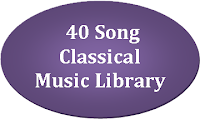 The 2-track (2-part) recorder/player on the C1 Air allows you to record a left and right hand part separately so you can play one at a time and then play them both back simultaneously or record one part/hand and then play the other part/hand live with the recorded part. This is really useful and practical when learning how to play a song using both your left and hand hand playing separate parts with bass clef and treble clef. It helps you hear how you are actually doing and it’s also like having a teacher with you because once you learn and play one part and record it, then you’ll be able to play that part back as often as you want to and then play the other hand/part against it so you have something to play with.
The 2-track (2-part) recorder/player on the C1 Air allows you to record a left and right hand part separately so you can play one at a time and then play them both back simultaneously or record one part/hand and then play the other part/hand live with the recorded part. This is really useful and practical when learning how to play a song using both your left and hand hand playing separate parts with bass clef and treble clef. It helps you hear how you are actually doing and it’s also like having a teacher with you because once you learn and play one part and record it, then you’ll be able to play that part back as often as you want to and then play the other hand/part against it so you have something to play with.
The classical songs in the 40-song library are the original full arrangements and will play one after the other automatically so you can just use it like a player piano if you want to and listen to them as they are (in my opinion) beautiful to hear and relax by. Korg does have their upgraded model called the G1B Air which can save and play 99 recorded songs, so that model has virtually no recording limitations in this way. The G1 Air also has other recording functions as well as other interesting features for people who want to upgrade assuming you have a slightly larger budget to do so.
 When it comes to connectivity to the piano, the C1 Air has a stereo line output and 2 stereo headphone jacks along with MIDI in/out connectors.Unfortunately there is no USB to external device connector so the only way to connect with a tablet (iPad) or computer to use external software or apps is to purchase an adapter cable with MIDI connectors on one end and a USB connector the other. This will allow you to connect the C1 Air to an external USB device with that adapter but it would have been more convenient and intuitive if the C1 had a regular USB connector built in like many other models out there.
When it comes to connectivity to the piano, the C1 Air has a stereo line output and 2 stereo headphone jacks along with MIDI in/out connectors.Unfortunately there is no USB to external device connector so the only way to connect with a tablet (iPad) or computer to use external software or apps is to purchase an adapter cable with MIDI connectors on one end and a USB connector the other. This will allow you to connect the C1 Air to an external USB device with that adapter but it would have been more convenient and intuitive if the C1 had a regular USB connector built in like many other models out there.
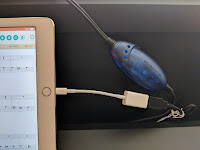
 That’s something which Korg should have done but is not a deal-breaker for me because an adapter cable can be purchased that will make things work but that cable adapter will cost you approximately $40.But once you do that then you can use all kinds of interactive iPad music educational and fun apps for learning to read music, understanding rhythm & timing better, and having a great time with interactive musical games. The ability to add musical learning apps and additional enjoyment to the C1 Air from an iPad is something I definitely recommend to everyone to enhance the learning and playing experience.
That’s something which Korg should have done but is not a deal-breaker for me because an adapter cable can be purchased that will make things work but that cable adapter will cost you approximately $40.But once you do that then you can use all kinds of interactive iPad music educational and fun apps for learning to read music, understanding rhythm & timing better, and having a great time with interactive musical games. The ability to add musical learning apps and additional enjoyment to the C1 Air from an iPad is something I definitely recommend to everyone to enhance the learning and playing experience.
Even the regular piano teaching curriculum by popular publishers such as Faber & Faber as well as Alfred that piano teachers and students are familiar with, have come up with their own teaching apps based on their music learning books.Some of those books have been digitized and made available from an app so you can see the music, hear the music play itself to be able to follow along with, and actually see the notes and how they move with the song. Along with that, you can slow down or speed up the lesson song and if you are playing the notes on the C1 Air piano following the notes in the lesson app and you play a wrong note, the app will recognize that you played a wrong note and then pause the song until you play the correct note…so it’s interactive, intuitive, and motivating to the student no matter what age you might be…pretty cool.
I will mention that when plugging in a pair of stereo headphones, the C1 Air has a special circuit built in called “sound optimization” which gives the headphone sound more of a 3D type surround sound effect kind of like you aren’t really wearing headphones because the sound feels like it’s going around your head and ears rather than straight into the ears as it would otherwise without that feature. Actually I do like it, but not all the time as the regular stereo headphone sound can actually be more natural sometimes depending on the music you are playing and the sounds you are selecting.
Fortunately you can turn that “surround sound” feature on and off depending on what you want. Speaking of wearing headphones, the stereo headphone amplification circuit inside the C1 Air is so good and so powerful that it literally sounds like you are hearing a grand piano in your head when wearing a good pair of stereo headphones.
The sound is loud and clear and very powerful assuming you like it that way, but of course you can always turn the volume down to whatever level you like. Some other digital pianos in a variety of price ranges that I have tried when using headphones can sound under powered and small, but not the C1 Air. Playing in privacy using good headphones is really an amazing listening experience as far as I am concerned and those kinds of things do impress me.
As far as the internal audio sound system goes, as I mentioned earlier in this review, that’s where the C1 Air is really impressive and makes the piano sound like it’s gigantic in size. The way the sound projects out of the speaker system and the fullness and richness of the tone is really surprising given the smaller compact size of the cabinet. When it come to big piano sound that will give you the impression you’re actually playing a real grand piano, the C1 Air really blows everything else away in this price range with its 50 watt powered sound system housed in its own speaker box chamber which helps the sound resonate more naturally. The sound also comes right at you instead of projecting away from you as it does in other digital pianos. It’s immediate sound gratification and in my opinion that’s what a lot of piano shoppers want…to be able to play a digital piano and have that piano really fill up the room like a real acoustic piano instead of sounding small and somewhat anemic like some other digital pianos can do.
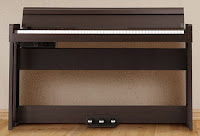 For instance, the Roland F701 compact digital piano which sells for $1449 only has just 24 watts of total power with 2 separate speakers pointing down towards the floor.The Yamaha Arius YDP-145 ($1299 internet price) has just 16 watts of total power with speakers pointing down underneath the piano rather than towards the player. The sound of that piano is definitely tinnier and thinner and it’s due to the under-powered speaker system with speakers pointing down towards the floor. It’s one thing to offer a reasonable good piano sound chip in a digital piano, but if the internal speaker system can’t put it out in a way that it sounds really good then that’s a problem as far as I am concerned…unless the piano is in a much smaller room or you generally want to play the piano quietly most of the time, then it’s fine.
For instance, the Roland F701 compact digital piano which sells for $1449 only has just 24 watts of total power with 2 separate speakers pointing down towards the floor.The Yamaha Arius YDP-145 ($1299 internet price) has just 16 watts of total power with speakers pointing down underneath the piano rather than towards the player. The sound of that piano is definitely tinnier and thinner and it’s due to the under-powered speaker system with speakers pointing down towards the floor. It’s one thing to offer a reasonable good piano sound chip in a digital piano, but if the internal speaker system can’t put it out in a way that it sounds really good then that’s a problem as far as I am concerned…unless the piano is in a much smaller room or you generally want to play the piano quietly most of the time, then it’s fine.
However, if you adjust the “brilliance” control on the C1 Air with a higher amount of brightness, then that livens up those higher frequencies quite a bit more which makes the sound clearer and more defined. So you can definitely “tweak” the piano sound in a variety of ways if if want to do that. The upgraded and slightly higher priced Korg G1 Air has an even more impressive internal speaker system than the C1 Air, so if you want to check that one out you can do it here at the following link: Korg G1 Air Review
 Now we need to ask the question…why does Korg call this piano C1 “AIR?” Well it’s not because there is air in the piano or that the piano fly’s in the air. It’s because the C1 Air has wireless Bluetooth connectivity to allow an audio song from an external device to be sent “through the air” wirelessley to the piano speaker system so that you can play hear a song from your Bluetooth capable cell phone or tablet (iPad), or computer music library through the C1 piano without need of connecting cables. This is a very cool feature and no other top name brand digital piano under $1500 that I know of can do this.
Now we need to ask the question…why does Korg call this piano C1 “AIR?” Well it’s not because there is air in the piano or that the piano fly’s in the air. It’s because the C1 Air has wireless Bluetooth connectivity to allow an audio song from an external device to be sent “through the air” wirelessley to the piano speaker system so that you can play hear a song from your Bluetooth capable cell phone or tablet (iPad), or computer music library through the C1 piano without need of connecting cables. This is a very cool feature and no other top name brand digital piano under $1500 that I know of can do this.

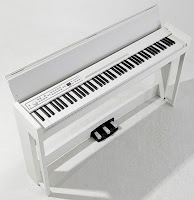 The piano cabinet is a nice small size which can fit into many small spaces and it come in 3 attractive cabinet colors including matte black, matte brown, and matte white. With the piano key cover closed the C1 Air measures just 53″ wide x 14″ deep x 30″ tall. With the key cover opened up then the piano height becomes 36″ tall. The weight of the piano is just 77 lbs so it’s very easy for 2 people to move it around. Another nice cabinet feature is that unlike other digital pianos in this price range including digital pianos for slightly more or less money, the C1 Air has front connected support legs built into the piano. This allows the piano to have more stability and keeps it from rocking back & forth as a few other digital pianos can do. Also the C1 Air includes a slow-closing key cover so when you lower the cover to close over the keys, the key cover does just come crashing down on your fingers.
The piano cabinet is a nice small size which can fit into many small spaces and it come in 3 attractive cabinet colors including matte black, matte brown, and matte white. With the piano key cover closed the C1 Air measures just 53″ wide x 14″ deep x 30″ tall. With the key cover opened up then the piano height becomes 36″ tall. The weight of the piano is just 77 lbs so it’s very easy for 2 people to move it around. Another nice cabinet feature is that unlike other digital pianos in this price range including digital pianos for slightly more or less money, the C1 Air has front connected support legs built into the piano. This allows the piano to have more stability and keeps it from rocking back & forth as a few other digital pianos can do. Also the C1 Air includes a slow-closing key cover so when you lower the cover to close over the keys, the key cover does just come crashing down on your fingers.
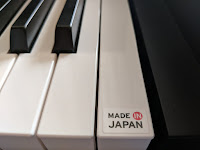 One more thing about this piano worth mentioning is something I do not normally talk about in my reviews. Many of the Japanese digital piano companies as well as the non-Japanese companies (Suzuki, Artesia, Kurzweil, etc) normally have their products manufactured in China, Indonesia, Malaysia, and/or other Asian countries because costs of doing business there are much lower than in Japan. Many years ago most Japanese designed products were also manufactured in Japan and the quality of those products made there were always much higher than products made in the other Asian countries. That has changed a lot now so that many items made in China, Indonesia, and other countries come out much better than before because those workers have better training and oversight. However, just about anything still made in Japan comes with higher quality and lower failure rates based on my experience with them.
One more thing about this piano worth mentioning is something I do not normally talk about in my reviews. Many of the Japanese digital piano companies as well as the non-Japanese companies (Suzuki, Artesia, Kurzweil, etc) normally have their products manufactured in China, Indonesia, Malaysia, and/or other Asian countries because costs of doing business there are much lower than in Japan. Many years ago most Japanese designed products were also manufactured in Japan and the quality of those products made there were always much higher than products made in the other Asian countries. That has changed a lot now so that many items made in China, Indonesia, and other countries come out much better than before because those workers have better training and oversight. However, just about anything still made in Japan comes with higher quality and lower failure rates based on my experience with them.Korg is the only Japanese digital piano company that I know which actually still has their digital pianos made in Japan in the Korg digital piano factory which they have had for many years. That’s pretty amazing considering the relatively low selling prices of their digital pianos and having them built in Japan with the high quality that they are known to have. So in my opinion that is definitely a “bonus” in terms of higher quality workmanship and longevity when it comes to Korg products as opposed to some other digital piano companies out there. Korg even offers a limited edition Ash color cabinet in the C1 Air as seen in the photo. The factory warranty on this model is 5 year parts and 5 years labor when registered on the Korg website after purchase of piano.
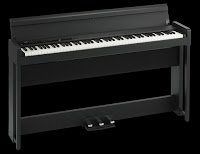 All in all, if you are considering a digital piano in this price range (around $1600 down to about $1000) I would recommend you definitely consider the Korg C1 Air as a very good choice, especially if your main goal is to play piano because that’s what this piano is really all about.Although it does other things, has other functions, and allows you to play other excellent, usable instrument sounds, it’s really all about the “piano playing experience” and not about having drum rhythms, hundreds of sounds, 16 tracks of recording, audio recording, interactive accompaniment tracks or apps, or other “bells & whistles.” The C1 Air has arguably the best, most convincing responsive weighted and graded piano key action out of any brand in this price range which comes from their top-of-the-line Korg professional series Kronos stage pianos.
All in all, if you are considering a digital piano in this price range (around $1600 down to about $1000) I would recommend you definitely consider the Korg C1 Air as a very good choice, especially if your main goal is to play piano because that’s what this piano is really all about.Although it does other things, has other functions, and allows you to play other excellent, usable instrument sounds, it’s really all about the “piano playing experience” and not about having drum rhythms, hundreds of sounds, 16 tracks of recording, audio recording, interactive accompaniment tracks or apps, or other “bells & whistles.” The C1 Air has arguably the best, most convincing responsive weighted and graded piano key action out of any brand in this price range which comes from their top-of-the-line Korg professional series Kronos stage pianos.This Korg home digital piano model has natural big stereo piano sound reproduction through its compact but yet impressive internal speaker system along with dependable pedaling with noticeably long damper decay-sustain time.This Korg C1 Air gives you the immediate impression you are hearing and feeling an acoustic baby grand piano instead of the more common upright piano sound with 2 very convincing sampled grand pianos at your disposal along with their useful variations. In my opinion the Korg C1 Air is at a very competitive price given what the “competition” has to offer, and the Korg C1 Air piano playing experience is very impressive in this price range for a bit over $1500 in my opinion.
Yes, there are a few downsides to this model such as only having standard MIDI connectors instead of the newer USB connectivity, so that can be somewhat of a inconvenience. Also, the recording feature in this model is very basic and quite limited. But aside from those things, I do like this Korg C1 Air and it just may by the perfect piano for you in its price range.
If you want more info on new digital pianos and LOWER PRICES than internet discounts, please email me at tim@azpianowholesale.com or call direct at 602-571-1864.






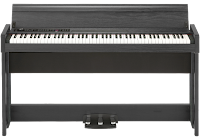

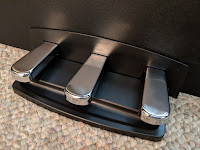
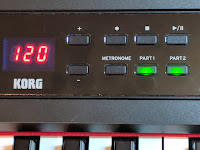


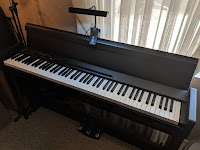
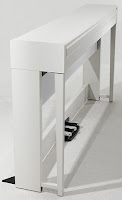










Best review of this upgraded Korg DP. My only question is can you use different apps on this model,apps like recording,notation,and other types of apps such as those that have drum beats/ auto accompaniment.If it would support those other apps that would be awesome! How about it?
Tim thank you so much for all the reviews, truly informative. I am a beginner in piano and I would love to learn. After long research I am between Yamaha Arius YDP 163, Roland F-140R, Kawai CN 17 and Korg C1 Air. Most interested I am for the last two. Which one out of the four would you choose? I am most interested about the acoustic piano sound and keys action authenticity. Thanks again, I will be looking forward to your thoughts.
Giorgos
Thanks for great reviews. I am considering Korg C1 Air or Korg G1 Air. What is the main differences between the two models, except size and that G1 has more more grand piano samples? Would a G1 be better fit for a bigger room, regarding sound volume and richness of sound?
Best regards
John
My understanding is that the G1 is a bigger and more powerful version, with 80 watts of power instead of 50. However the C1 is pretty powerful and I think it can fill a big room with great sound.
Hi Tim,
Thank you for these great reviews that are extremely helpful for me to understand digital piano market. I am considering to purchase one, but can't make decision on Korg C1 Air or Casio AP-470. What are the main differences of these two?
Many thanks,
Ping
Excellent review, thanks for all the detail. It mirrors my experience with the Korg C1 Air. I could not be happier with the sound, feel, & build quality. I love playing my C1 Air.
Hi Tim,
One more question, the only difference between the LP380 and the C1 Air is the absence of the Bluetooth on the LP380? (and less powerful speakers).
Thanks,
Szilárd
Hi Tim,
this is the best digital piano review I have ever read. I hesitated between the F140R and the C1 Air and after reading your review it is clear what to choose. Thanks
Szilárd
I had Korg D1, but found piano sounds disappointing a little bit which would force me to use ravenscroft 275 vst and it served as a barrier to just sit and play piano more often. are piano sounds on c1 a noticeable upgrade? from what i understand korg g1 gets more nuanced samples (like c1 gets 4gb samples and g1 8gb) and better speakers? i like c1 small footprint and i like both dp for front facing speakers as I intend to put my dp under huge TV and use as a speaker. so here is another question: can you play music/audio through c1/g1 speakers with the lid closed or they turn off automatically after you close the lid? that would be disappointing 🙂
Fantastic review, I have shared;)
If I am not wrong, each Korg C1 piano note needs 4 partials, so the true polyphony is 120:4=30 notes. Am I wrong?